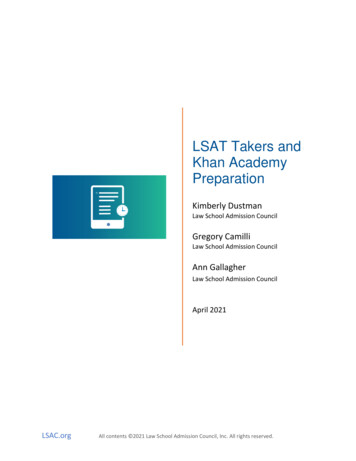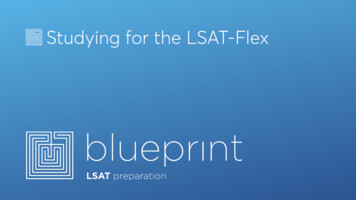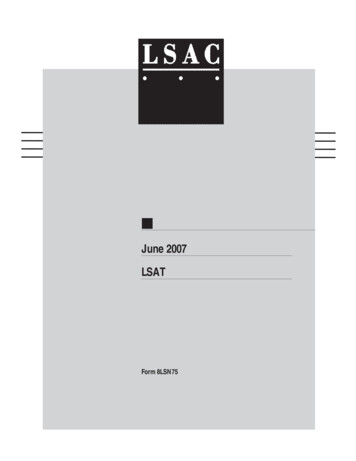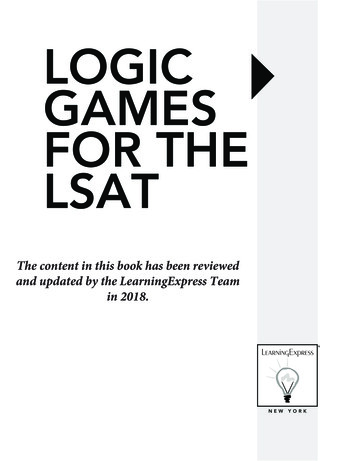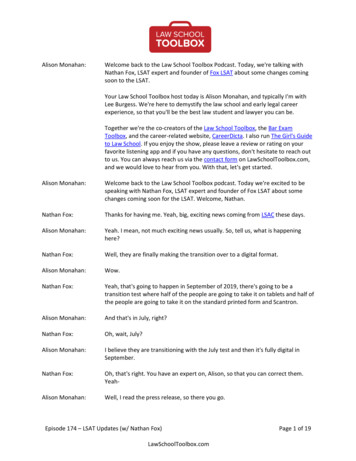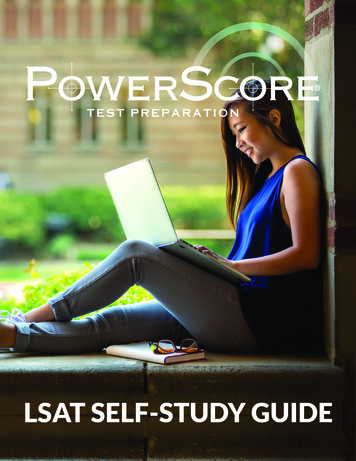
Transcription
LSAT SELF-STUDY GUIDE
Copyright 2010-2017 by PowerScore Incorporated.All Rights Reserved. No part of this publication may be reproduced, stored in a retrieval system, ortransmitted in any form or by any means electronic, mechanical, photocopying, recording, scanning, orotherwise, without the prior written permission of the Publisher. Parts of this book have been previouslypublished in other PowerScore publications and on the powerscore.com website.LSAT, PrepTest, 10 Actual, Official LSAT PrepTests, 10 More Actual, Official LSAT PrepTests, The Next 10 Actual,Official LSAT PrepTests, and The Official LSAT SuperPrep are a registered trademarks of the Law SchoolAdmission Council, Inc.PowerScore is a registered trademark. The LSAT Bible SeriesTM, The Logic Games BibleTM, The Games BibleTM, The LogicalReasoning BibleTM, The Reading Comprehension BibleTM, The Logic Games Bible WorkbookTM, The Logical ReasoningBible WorkbookTM, The Reading Comprehension Bible WorkbookTM, The Game Type Training SeriesTM, The QuestionType Training SeriesTM, The Passage Type Training SeriesTM, The LSATs Deconstructed SeriesTM, are the exclusive servicemarked property of PowerScore. Any use of these terms or of these systems without the express written consent ofPowerScore is prohibited.Published byPowerScore Publishing, a division of PowerScore Incorporated57 Hasell StreetCharleston, SC 29401Author: David M. KilloranPublished in the United States02 23 20 172POWERSCORE TEST PREPARATION
THE POWERSCORE LSAT SELF-STUDY GUIDEOkay, you’ve made the decision to prepare for the LSAT on your own. Good call!This guide will help you get started, help identify the materials you need, andprovide you with a comprehensive self-study plan.Let’s quickly outline the basic steps you need to take, and if you have alreadycompleted any of these steps, just skip ahead to the next item on the list.1. Take a Practice LSAT. 42. Analyze Your Results. 63. Collect Relevant Study Materials. 74. Set Up a Study Plan. 105. Stick to Your Study Plan. 136. Review Your Progress and Make Changes as Needed. 137. Take the LSAT and Destroy It!. 13THE POWERSCORE LSAT SELF-STUDY GUIDE3
1. Take a Practice LSATYour first step should be to take an actual, released LSAT and establish a baseline score.Taking an actual LSAT will give you several benefits:A. You will become familiar with the types of questions presented on the exam,and the language patterns the test makers use.B. You will get a sense of the endurance and concentration required to completethe exam.C. You will get a starting score and a snapshot of where your strengths andweaknesses lie.Fortunately, you can get started with this process immediately, and for free! LSAC (thecompany that administers the LSAT) makes a real LSAT available on their site for freedownload:The June 2007 o take the exam, follow these guidelines:According to LSAC, the four section tests should be taken back-to-back, whichwill require approximately 2 hours and 20 minutes. A scoresheet is included thetest download file so that you can record your answers.Per LSAC protocol, here are the directions for taking a four-section test undertimed conditions:Section I.35 minutesSection II.35 minutesSection III.35 minutesSection IV.35 minutes4POWERSCORE TEST PREPARATION
During the test you are allowed to work only on the section being timed. Youcannot go back or forward to work on any other section of the test.You may not use any scratch paper while working on the test; only the test pagesthemselves are available for your use.Please use a number 2 pencil for your answer sheet. You may use an eraser anda highlighter, if needed.You may not eat or drink during a timed section.You can also use our Free Virtual LSAT Proctor module we have in our Free LSAT HelpArea (http://www.powerscore.com/lsat/help/content index.cfm). The Virtual LSATProctor can time your exam and provide you the verbal warnings given during the actualLSAT (just hit the “play” button in the lower left-hand corner of the screen when thepage opens).Regardless of what proctoring method you use, follow the guidelines rigidly, and put inyour best effort! The more realistic your results, the better decisions you can make laterwhen setting up a study plan.Finally, no matter what your result, do not overemphasize the score you receive. Youtake an initial practice LSAT in order to establish a baseline and to learn a little bitabout how the test works, and you should expect to significantly improve over this firstperformance.THE POWERSCORE LSAT SELF-STUDY GUIDE5
2. Analyze Your ResultsOnce you complete your practice LSAT, visit our free Self-Study Help Area (https://studentcenter.powerscore.com/self-study), and create a free student account. Withyour account, you can score every LSAT you take and receive a free statistical analysis ofyour performance. The breakdown is invaluable to helping you identify your areas ofstrength and weakness.What each person considers a “good” LSAT performance is to some degree relative tothe range of schools one is considering. If you are considering schools like Harvard,Berkeley, Michigan, or Georgetown, a good LSAT performance is in the upper 160s and170s, and you have to go all-out for the highest possible score you can achieve (everypoint counts, especially at the ultra-competitive top schools). This is also an excellentgeneral strategy for any student, because sometimes a student who starts with a fairlymodest target law school discovers that their LSAT score opens up many new, attractivepossibilities.On the other hand, if you have a particular school or set of schools in mind, you may beable to determine that a certain score will be sufficient to gain admission. For example,for New York Law School, a good score is somewhere in the 150s, and with a 3.0 GPA, ascore of 155 would probably guarantee admission. While we believe that every studentshould shoot for 180 (because even if you fall short, you still do extremely well), it maybe that you do not need to put in the time required to get a score in the upper range.Only you can set your scoring goal, and you should do that early in the process, and afterseriously considering the types of schools you are interested in attending.Once you have a general idea in mind for a target score, it is time to look carefully atyour baseline LSAT results. Take a look at the following areas, and ask the followingquestions:A. Your overall score. How far away are you from your target?B. Your score on each individual section. What’s your best section? Your weakestsection? Identifying your weakest section will give you a starting point for yourstudies.C. Within each section, what question types or game types gave you the mostdifficulty? Again, this information can be used to focus your studies when usingup your study plan.6POWERSCORE TEST PREPARATION
3. Collect Relevant Study MaterialsThere are a variety of LSAT books available to students, and they fall into threecategories:A. LSAT preparation guides containing strategies and techniquesB. Collections of complete LSATs or individual questionsC. Question explanation booksTo successfully self-prepare for the exam, books from all three categories can be helpful.Let’s discuss some of the available options.LSAT Preparation GuidesQuality LSAT study guides typically focus on individual sections of the LSAT, anddepending on your performance above, you should select guides for each area givingyou difficulty. For example, if Logic Games was your weakest section, look to buy guidesthat specialize in Logic Games. As far as individual books, we are of course partial to ourwell-known PowerScore LSAT Bibles (but don’t take our word for it—we urge you to visitAmazon or any LSAT discussion forum and see what others have to say).There are some book options where you can buy a book that attempts to explain allthree sections of the test. We tend to be less impressed with these books because theyusually cover each section very superficially. The LSAT is not an easy or superficial test,and a book that covers the entire LSAT in 400 pages or so cannot go into each sectionvery deeply. http://www.powerscore.com/lsat/publications/THE POWERSCORE LSAT SELF-STUDY GUIDE7
LSAT Question CollectionsAs you learn LSAT tips and techniques, you will need to practice with them extensively. The bestsource for practice materials are the LSAT PrepTests released by LSAC, the administrators of theLSAT. LSAT PrepTests are authentic, previously administered LSATs, and they provide the closestapproximation to the exam you will ultimately take. These are the best collections of LSATs, withnotes on each:A. 10 Actual, Official LSAT PrepTests Volume V, 10New Actual, Official LSAT PrepTests , The Next 10Actual, Official LSAT PrepTests, 10 More Actual,Official LSAT PrepTests , and 10 Actual, OfficialLSAT PrepTests. These are collections of 10 LSATseach, and they are the cheapest way to get a lotof LSATs. They are listed in order of recency, so ifyou only buy one or two, get the first books onthis list.B. Individual LSAT PrepTests. There are a largenumber of individual LSATs available (such asThe Official LSAT PrepTest 74, The December2014 LSAT). Buying individual tests is currentlythe only way to get the most recent exams. Thedownside is that the individual exams cost moreper test than the collections of 10 LSATs above.At the least, get the three most recent exams.C. Individual Question Type Collections. In orderto directly attack specific weaknesses, somestudents buy books focused just on certainquestion types. For example, PowerScorepublishes LSAT Game Type Training, whichallows students to work just on certain types ofLogic Games.The books above are available from LSAC directly at www.lsac.org, PowerScore.com, or Amazon.8POWERSCORE TEST PREPARATION
Question Explanation BooksAlthough any good study guide will explain the questions contained in the text, no study guideexplains questions not in the book. For that, you need to purchase books that contain questionsand/or corresponding explanations. These are the best out there:A. The Official LSAT SuperPrep. This book contains threepreviously unreleased LSATs, with complete explanationsfor each question from LSAC. Although they don’t alwaysprovide explanations that clearly explain the correctstrategy for attacking a question (think about it: do theyreally want you to know exactly what they are thinking?),reading the explanations gives you a sense of how theythink about the questions. And, because understandingtheir mindset is critical to LSAT success, this is a book you should have in yourcollection.B. The PowerScore LSAT Workbook Series. This series presents drills and questionsfor each section type, and then provides complete explanations for each problem.These are great tools if you want to practice with the techniques from each LSATBible, and study how those strategies are applied to a variety of questions.Finally, aside from the books above, you will need a good timer and a healthy set of pencils. Thetimer—a standard kitchen timer, watch, stopwatch, or test timer will do—is an important tool inhelping you become comfortable with the time constraints of the LSAT. More on this in the nextsection.THE POWERSCORE LSAT SELF-STUDY GUIDE9
4. Set Up a Study PlanOnce you have completed the first few steps above, it is time to select a study plan. Toa great extent, your plan is affected by how much time you have until you take the LSAT(see When to Take the LSAT for more information: http://www.powerscore.com/lsat/help/when.cfm). Because the LSAT is not a test that lends itself well to cramming, thebasic rule is this: the more time you have to prepare, the better off you will be. So, ifpossible, start early!To make your LSAT preparation easier, we have created a set of free self-study plans thatare based on our LSAT Bibles. These detailed plans can be found on the PowerScore SelfStudy Site. You can select from the following options:6-WeekStudy Plan2-MonthStudy Plan3-MonthStudy Plan4-MonthStudy Plan6-MonthStudy PlanEach plan is extremely comprehensive, and details the steps you need to take to achievethe best possible LSAT score. Simply select the plan that is closest to the amount of timeuntil you take the LSAT, and then start y/index.cfmAs an overview, each study plan uses the following pedagogicalprinciples:A. The plans start by having you learn the fundamentalsof the LSAT, and focus on strategies and techniques.The goal here is to first learn how to bestapproach the LSAT. The more you know aboutthe test itself and the best methods for solvingquestions, the better you can score.B. Practice on specific question types is a majorfeature of each plan, because you have toregularly apply the methods you learn in orderto become as fast and efficient as possiblewith them.10POWERSCORE TEST PREPARATION
C. At designated intervals you are directed to take full practice tests. Taking fullLSATs is critical to becoming as comfortable as possible on test day.One of the major problems for all LSAT takers is fatigue during the exam. TheLSAT is a long, draining test, and by frequently taking full practice exams, youbecome acclimated to the rigors of test day.D. Thorough reviews of your practice sessions and test results are built in so youcan track improvement and identify areas of difficulty.This portion of your preparation is critical. You must closely examine everyquestion on each test you take—both the questions you answered correctly(could you have been faster or more certain?) and the questions you answeredincorrectly (to see where you went wrong and to learn how to avoid those issuesnext time).E. Your practice test results can be used to revise your general study plan toaccount for changes and improvements.As you progress through your course of study, you will improve in some areasand find other areas that still need more work. Use your practice test results toidentify these areas. For example, if you keep running into difficulty with LogicGames, you can slant your study time to allow you to do more games and reviewmore material about games. The old saying that a chain is only as strong as itsweakest link applies to your testing as well. If you have a weakness, find it andwork relentlessly to eliminate it!THE POWERSCORE LSAT SELF-STUDY GUIDE11
One question that frequently comes up concerns timing and using a timer whilestudying. Timing, while always important on the LSAT, should not be a primaryconcern for you when you begin your studies (and the further out you beginpreparing, the less that timing should concern you). As you go through morematerial, however, you should begin to make timing a regular part of yourpreparation. For example, when you begin your studies you should keep an eye onthe amount of time you take to complete each question, but you should not obsessover it. If you are taking longer than desired, make note of that fact, but focus moreon understanding the concepts in the questions and the methods to solve them.Practice is not about starting at full speed; it is about understanding the fundamentalsteps and slowly working your way up to full speed.To keep things interesting while studying, you can use different timing strategies,such as timing yourself on a set of two or three questions, and then reviewing yourperformance. Or you could time yourself on a set of five or ten questions, and thengo back and review each question carefully after you complete the set. The goal oftiming yourself is for you to gain a clear understanding of how fast you can movethrough questions, as well as to develop an internal clock that gives you a generalidea of your pacing. The farther you progress in your studies, the more frequentlyyou should time yourself. But remember, when you encounter a new concept—especially one that you find difficult—set aside the timer until you are comfortablewith the idea itself. Then start timing and tracking your performance again.12POWERSCORE TEST PREPARATION
5. Stick to Your Study PlanGetting the materials together and selecting a study plan are the easy parts. Sticking tothe plan is much more difficult!When you set your schedule, do not generalize. For example, don’t say, “I want to studyat lot this week” or “I want to take a practice test sometime.” Instead, be specific. Say,“I want to study every day except Monday and Friday for at least 2 hours a day” or “I’mgoing complete every item on the study plan this week by Friday.” Creating specific goalswill help you stick to the schedule more easily, and it will give you an ironclad guide forknowing whether or not you are following your plan.6. Review Your Progress and Make Changes as NeededIn war, the battle plan sometimes changes and adjustments have to be made asthe campaign continues. The same holds true for your LSAT preparation (that’sright, it’s war!). At the outset, you may draw certain conclusions about yourtest performance or your study schedule that subsequently change overtime. Constantly revisit your progress and use your practice test results torevise your estimations of needed study time and your areas of strengthand weakness.What happens if you find yourself in trouble or if you can’t keep upwith your schedule? If so, you have a few options:A. Postpone your LSAT date. Depending on when you are sittingfor the LSAT, you may have the option of delaying your testwhile still not losing out on the current application -earlyB. Seek professional assistance. No, we don’t mean psychologicalhelp! We mean professional LSAT help. If you feel that selfstudying isn’t giving you the results you want, or if you simplyneed a jump-start to your studies, you can avail yourself ofseveral different options. For example, you can work with an LSATtutor for a few hours, attend a Weekend LSAT Course, or sign upfor a Live Online LSAT Course.7. Take the LSAT and Destroy It!This is your ultimate goal, and if you are dedicated and diligent you canachieve it! Study hard and good luck!THE POWERSCORE LSAT SELF-STUDY GUIDE13
THE POWERSCORE LSAT SELF-STUDY GUIDE Okay, you've made the decision to prepare for the LSAT on your own. Good call! This guide will help you get started, help identify the materials you need, and provide you with a comprehensive self-study plan. Let's quickly outline the basic steps you need to take, and if you have already


